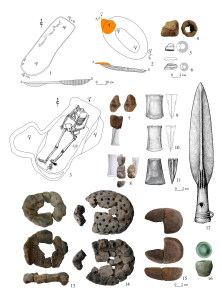 Vyacheslav I. Molodina,b,#, Igor A. Durakova,## and Lilia S. Kobelevaa,b,###
Vyacheslav I. Molodina,b,#, Igor A. Durakova,## and Lilia S. Kobelevaa,b,###
aInstitute of Archaeology and Ethnography, Siberian Branch of the RAS, Novosibirsk, Russia
bTomsk State University, Tomsk, Russia
#E-mail: priemnaya.molodina@gmail.com
##E-mail: idurakov@yandex.ru
###E-mail: lilyakobeleva@yandex.ru
Keywords: Western Siberia, the Bronze Age, bronze foundry, the Odino, Krotovo, Andronovo (Fyodorovo), and Irmen cultures
The paper traces through several consecutive periods of the development of bronze foundry production in the Ob-Irtysh interfluve during the Bronze Age. At the first stage, copper-bronze products appeared in the area as imports. The local foundry emerged no earlier than the beginning of the III millennium BC on the sites of the Odino and Krotovo cultures. At that time, the technological base was being formed, including thermal facilities and developed foundry equipment (crucibles, ladles, molds, and nozzles). This process is largely synchronized with the emergence and development of Seima-Turbino technologies in the Ob-Irtysh forest steppe. A sharp change in this line of development was taking place since the beginning of the II millennium BC as a result of increasing expansion of the Andronovo (Fyodorovo) population. Their arrival led to the modification of part of the production process associated with the metal melting (hearths and crucibles). At the same time, it should be noted that all molding processes have retained the features of local foundry production developed by the Krotovo people. The production technology developed as a result of this synthesis formed the basis for the foundry of the Irmen culture in the Late Bronze Age. A sharp change in a number of production techniques occurred only at the end of that period and is associated with the penetration of the Ural-Kazakhstan production traditions into western regions of the Baraba forest-steppe.
DOI: 10.31857/S0869606323040141, EDN: YHSSXW







